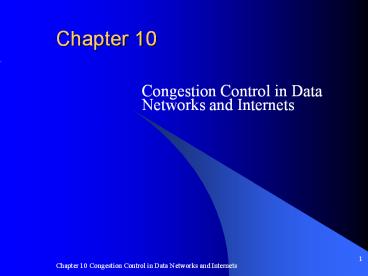Congestion Control in Data Networks and Internets - PowerPoint PPT Presentation
1 / 13
Title:
Congestion Control in Data Networks and Internets
Description:
Congestion occurs when number of packets transmitted approaches ... Practical Performance ... provide assured service to applications is to use a ... – PowerPoint PPT presentation
Number of Views:116
Avg rating:3.0/5.0
Title: Congestion Control in Data Networks and Internets
1
Chapter 10
- Congestion Control in Data Networks and Internets
2
Introduction
- Congestion occurs when number of packets
transmitted approaches network capacity - Objective of congestion control
- keep number of packets below level at which
performance drops off dramatically
3
Queuing Theory
- Data network is a network of queues
- Packet arrive, they are stored in the input
buffer of the corresponding port - The node examines each incoming packet, makes a
routing decision, moves the packet to the
appropriate output buffer - This is statistical time division multiplexing
- If arrival rate gt transmission rate
- then queue size grows without bound and packet
delay goes to infinity
4
Congestion in Data Networks and Internets
- Congestion the number of packets being
transmitted through a network begins to approach
the packet-handling capacity of the network. - Input and output queues at switch or router
- Any given node has a number of I/O ports attached
to it. - There are two buffers at each port, one to accept
arriving packets, and one to hold packets that
are waiting to depart. - Buffer size fixed-size or variable-size
- If packets arrive too fast for the node to
process them ? input buffer overflow - If packets arrive too fast than packets can be
cleared from the outgoing buffers ? output buffer
overflow
5
At Saturation Point, 2 Strategies
- Discard any incoming packet if no buffer
available - Saturated node exercises flow control over
neighbors - May cause congestion to propagate throughout
network
6
Ideal Performance
- I.e., infinite buffers, no overhead for packet
transmission or congestion control - Throughput increases with offered load until full
capacity - Packet delay increases with offered load
approaching infinity at full capacity - Power throughput / delay
- Higher throughput results in higher delay
7
Assumption buffer is infinite size Power
throughput / delay Delay propagation delay (from
SA to DA) processing delay (at each node)
queuing delay (variable delay)
8
Practical Performance
- buffers are finite
- With no congestion control, increased load
eventually causes moderate congestion throughput
increases at slower rate than load - Further increased load causes packet delays to
increase and eventually throughput to drop to zero
9
- In practice, buffers are finite
- If congestion, the exchange of control signals
for the congestion consume network capacity - Point A throughput increases rate is slower than
the rate of load increase (have control signals) - Point B buffer overflow, packet discard,
retransmission packet increase
10
Congestion Control
- Backpressure
- Request from destination to source to reduce rate
- Choke packet ICMP Source Quench
- Implicit congestion signaling
- Source detects congestion from transmission
delays (ACK packet incurs long delay) - Packets are discarded (time out occurs)
- ? reduces flow
11
Explicit congestion signaling
- Direction
- Backward
- the congestion avoidance procedures should be
initiated in the opposite direction of the
received packet - Forward
- the congestion avoidance procedures should be
initiated in the same directions the received
packet. The information may echo to the source
station with congestion packet or with window
size (TCP) - Categories
- Binary
- a bit is set in a data packet to indicate the
congestion. The source receives a binary
congestion indication, it reduces its traffic
flow - Credit-based
- like TCP slice window size, the destination
allows the sender an explicit credit that the
sender only can send the amount of the credit
packets - rate-based
- provide an explicit data-rate limit to the
source. The source may transmit data at a rate up
to the set limit. To control congestion, any node
along the path of the connection can reduce the
data rate limit in a control message to the
source.
12
Mechanisms for congestion control
13
Traffic Management
- Design issues related to congestion control
- when a node is saturated and must discard
packets, the discard policy may consider
following issues - Fairness
- Various flows suffer from congestion equally
- Last-in-first-discarded may not be fair
- Quality of Service
- We might wish to treat different traffic flows
differently - Voice, video delay sensitive, loss insensitive
- File transfer, mail delay insensitive, loss
sensitive - Interactive computing delay and loss sensitive
- Reservations
- One way to avoid congestion and to provide
assured service to applications is to use a
reservation scheme - The network agrees to give a defined QoS so long
as the traffic flow is within contract parameters - Policing excess traffic discarded or handled on
best-effort basis































